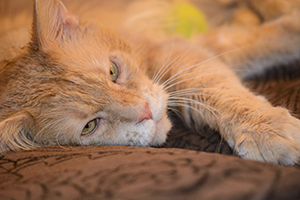What is Feline Immunodeficiency Virus (FIV)?
Feline Immunodeficiency Virus (FIV) was first discovered in 1986 when cats started showing signs of immunodeficiency-like illnesses, similar to the symptoms seen in people with human immunodeficiency virus (HIV). In fact, FIV is classified in the same family of viruses as HIV. These viruses are all species-specific, meaning FIV cannot be transmitted from cat to human, and humans can’t transfer HIV to cats. Unfortunately, there is no treatment for FIV, and once infected, your cat will carry the virus for the remainder of his life.
Signs & Symptoms
Shortly after initial FIV infection, your cat’s white blood cell count begins to decline, causing progressive impairment of your cat’s immune system. Many cats will remain without symptoms for several years. Medical signs and symptoms are usually due to secondary infections and chronic degenerative conditions. Symptoms may include:
- Inflammation and chronic gingivitis in the mouth
- Diarrhea
- Fever
- Pneumonia
- Poor coat condition
- Loss of appetite
- Weight loss
- Skin disease
- Sinus infections
- Neurological problems
Many cats infected with FIV live a long life, especially if routine wellness care is provided to aid early disease detection, and exposure to other infectious disease is limited.
How is FIV Transmitted?
Transmission most commonly happens through bite wounds. FIV virus is contained in the blood, saliva, and cerebrospinal fluid of infected cats. The virus is fragile outside the body and does not survive in the environment.
Transmission through close contact, as with feline leukemia virus (FeLV), occurs rarely. FIV may be transmitted to unborn kittens if their mother is infected during pregnancy. FIV is found in cat populations worldwide.
How Can I Prevent My Cat from Getting FIV?
The best way to prevent infection is by minimizing exposure to infected cats. Outdoor cats are more likely to contract FIV than indoor cats, and male cats are twice as likely to be infected due to their tendencies to roam and fight. Spaying and neutering you cat can help decrease these roaming and fighting tendencies.

Vaccination and Testing for FIV
Vaccines for FIV are not available in many locations including the US and Canada, and not all cats will be protected by the vaccine. Also, it is not currently recommended for all cats. The decision on whether or not to vaccinate your cat should be made on a case-by-case basis after consulting with your veterinarian.
The routine test for FIV (ELISA blood test) detects antibodies against the virus and not the virus itself, so the vaccination will cause your cat to test positive. A second, confirmatory test (PCR test) may help differentiate a vaccinated from a truly infected cat, but results from this test are sometimes hard for your veterinarian to interpret. Therefore, any cat which is vaccinated against FIV should be permanently identified with a microchip, tattoo, or collar.
It’s also important to note, that cats infected with FIV may take up to 60 days to test positive. Testing should be repeated by your veterinarian at least 60 days later to ensure your cat is truly not infected.
Management
If your veterinarian has confirmed that your cat has FIV, you should work together to create a plan to keep your cat healthy and happy for as long as possible. You should keep your cat indoors to prevent the spread of FIV-infection to other cats in the neighborhood and to reduce their exposure to infections. Consult with your veterinarian about getting your cat spayed or neutered. Feed your cat a well-balanced diet that is suited to his needs. Schedule check-ups for your cat every six months to monitor his weight, symptoms, and general health. If you notice any changes in your cat’s behavior or health, call your veterinarian immediately.


